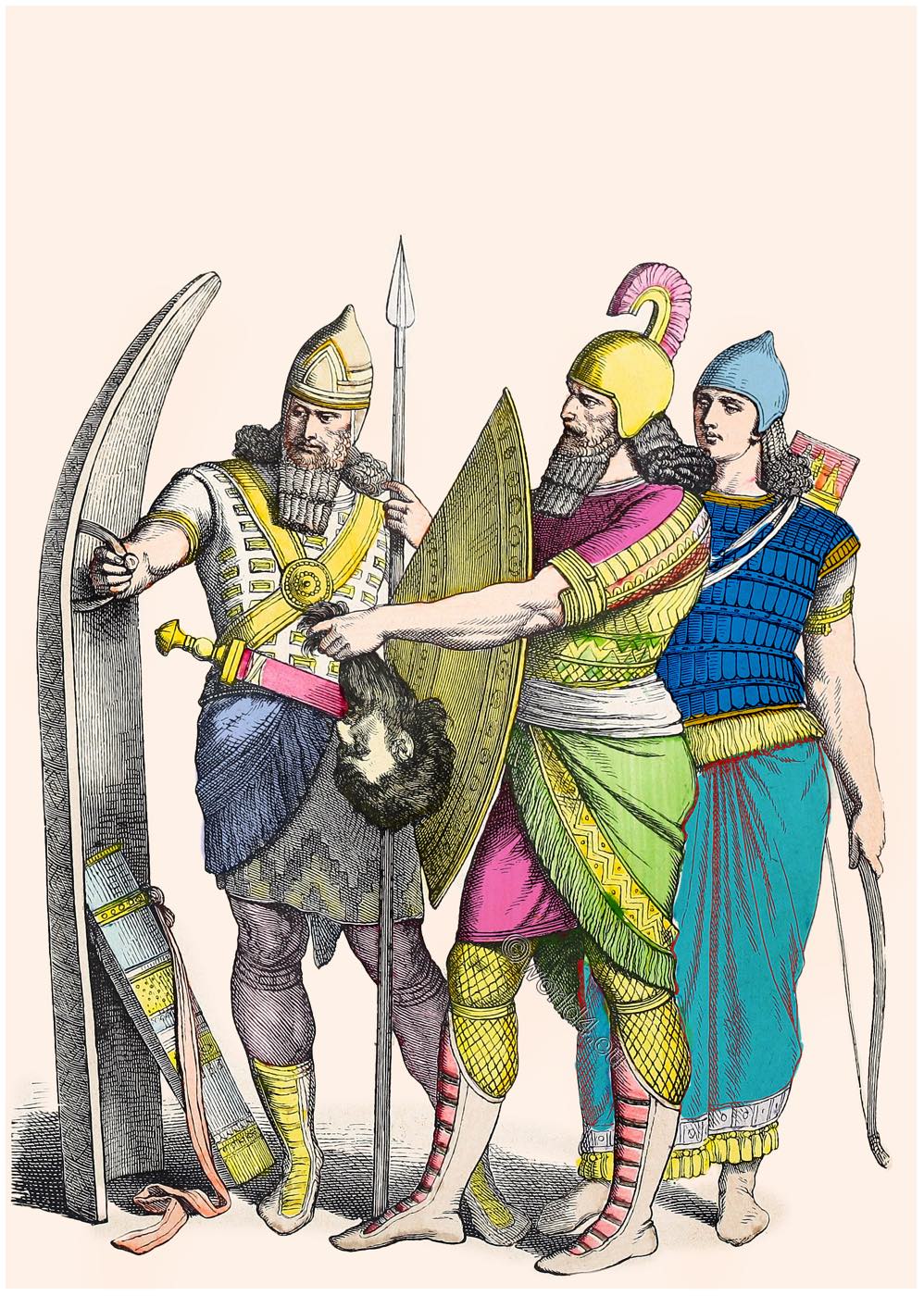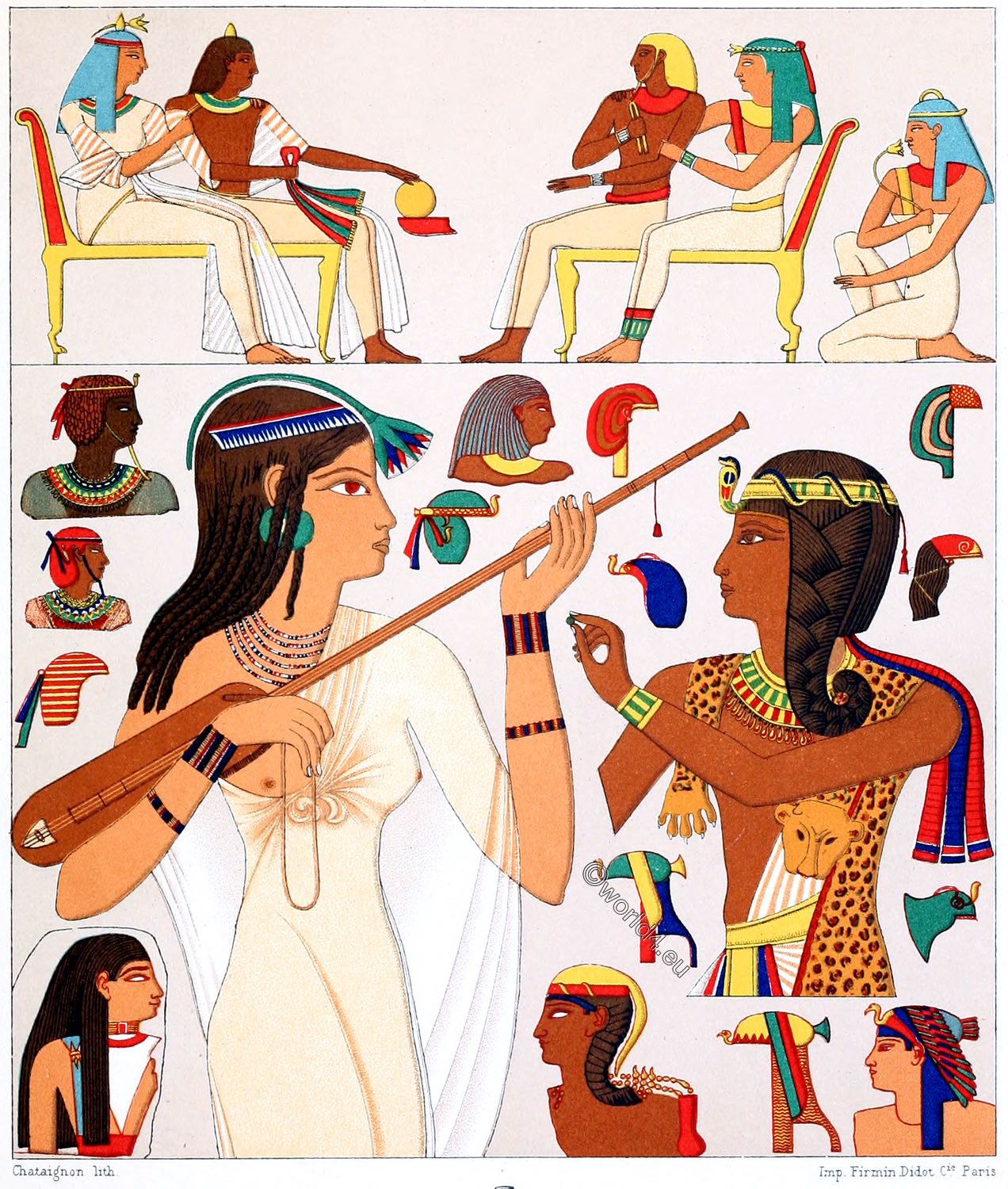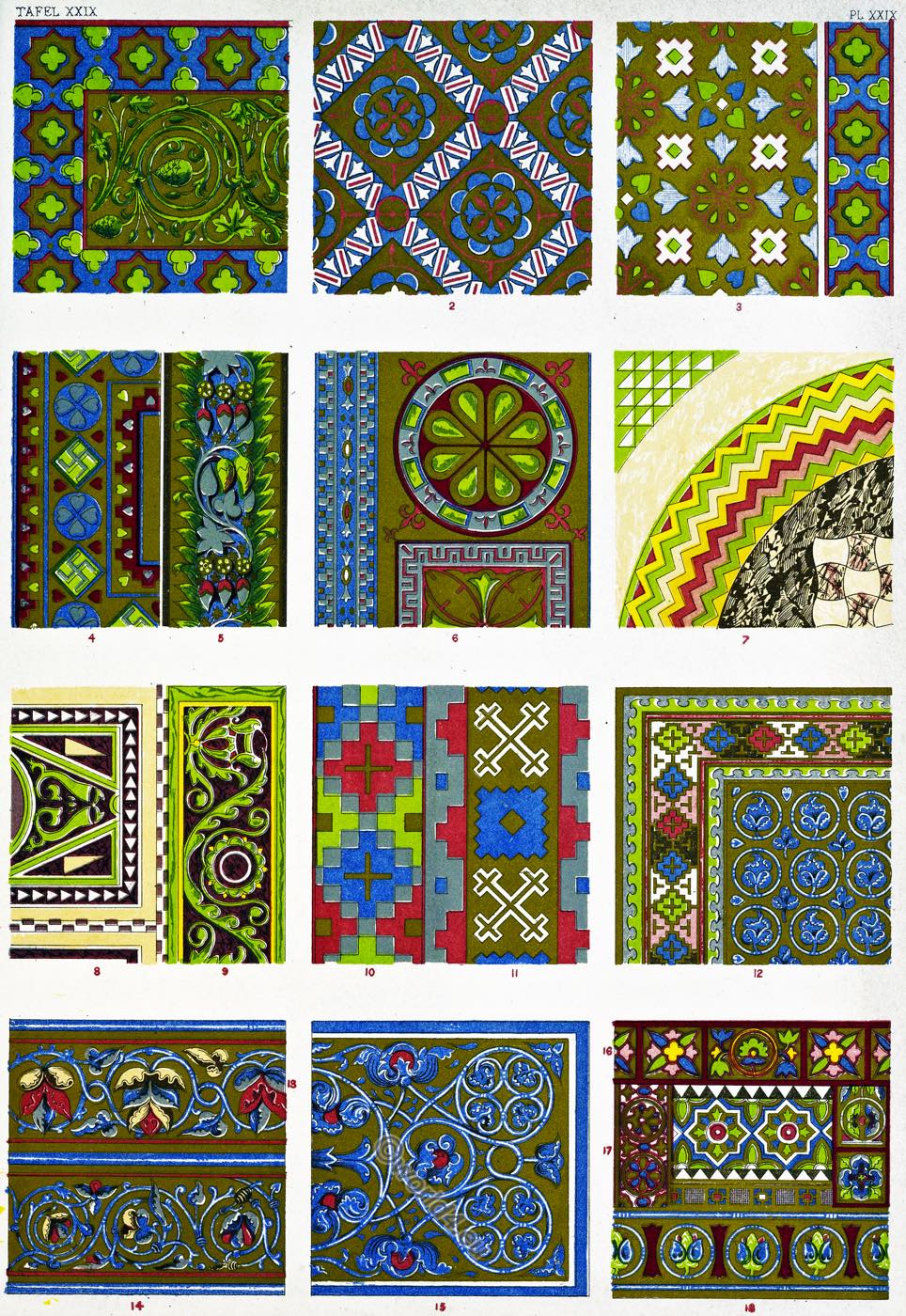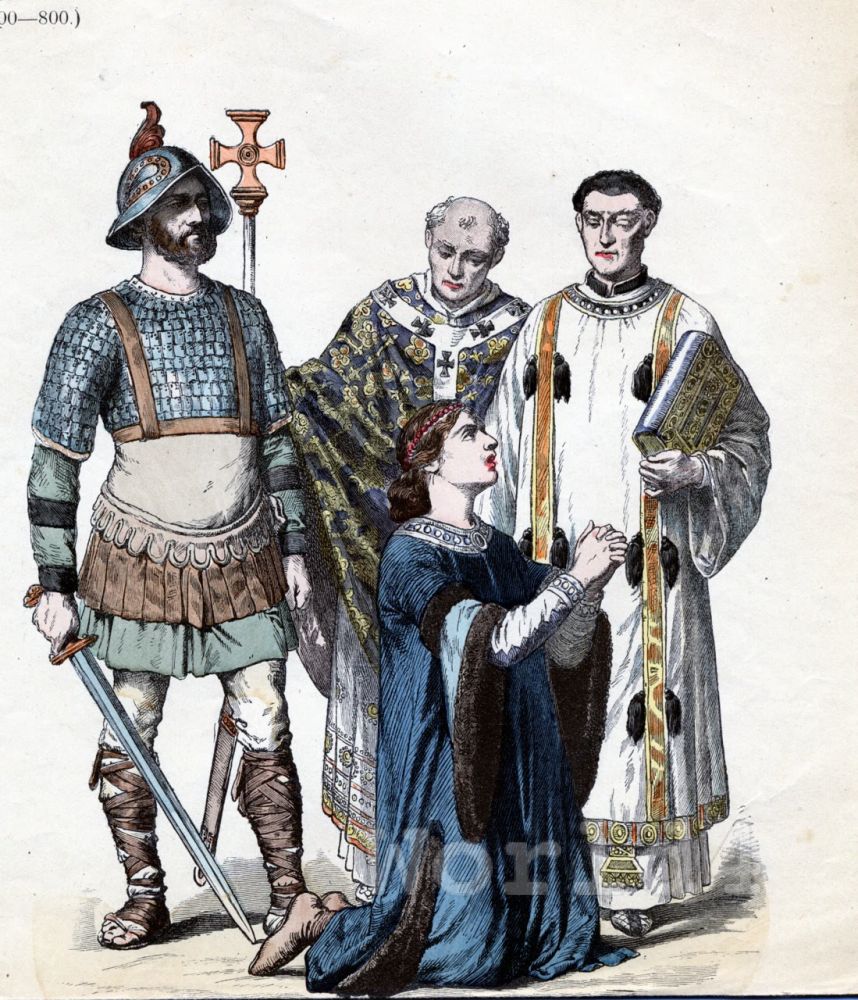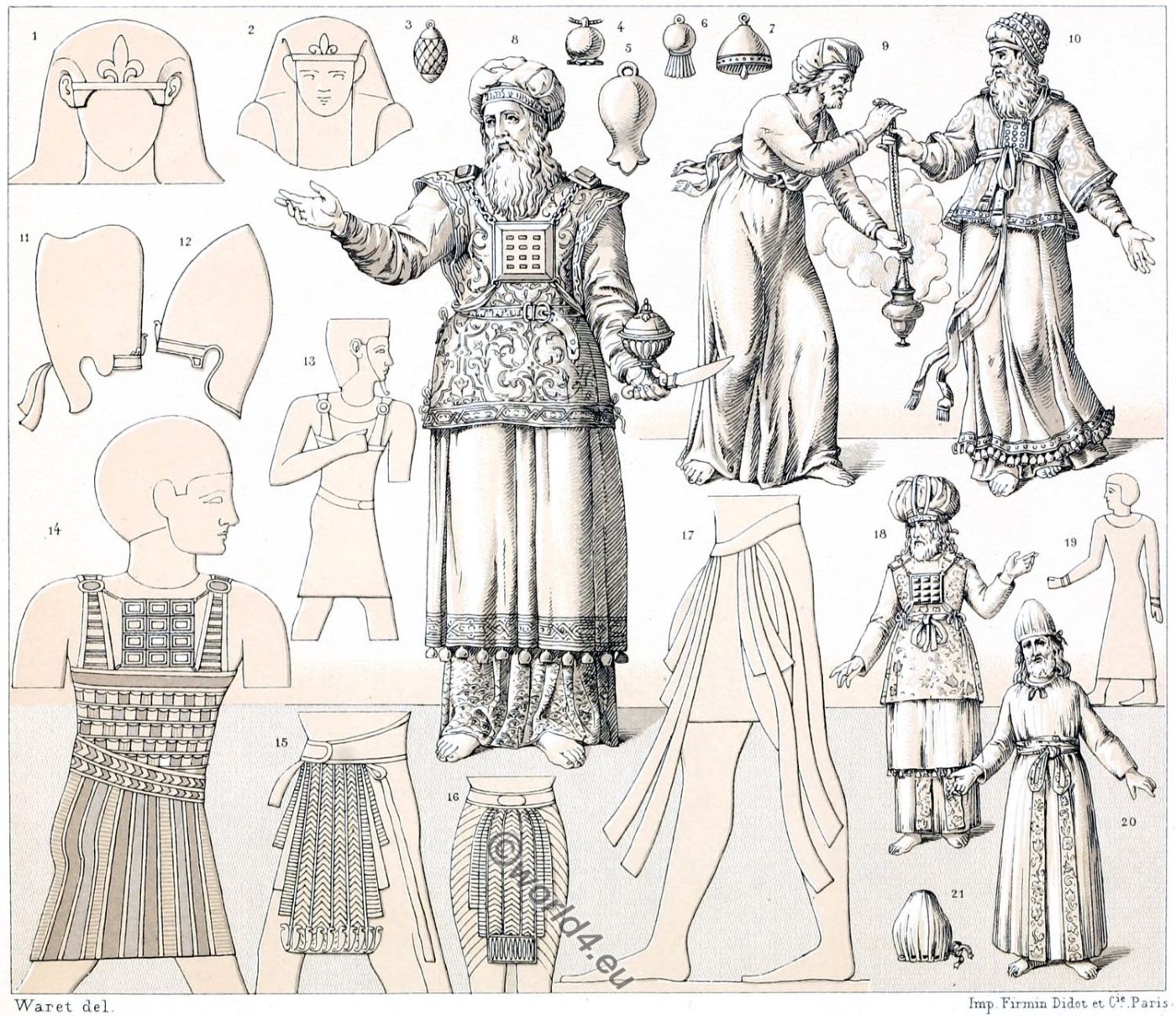
HEBREW. THE PRIEST’S COSTUME. SIMILARITY OF THE HEBREW AND EGYPTIAN PRIESTLY COSTUME.
The numerous analogies of the ritual prescriptions of Moses with ancient Egyptian customs are established. In the priestly costume they are unquestionable, especially concerning fabric and colour.
The costume of the priests consisted of four pieces; the trousers, the tunic, the belt and the high bonnet. The trousers (mischnasaim) reached up to the hips. The tunic (chethoneth) was close-fitting, had sleeves and went down to the feet. It was made of one piece and had an opening at the top, which was closed on the shoulders by cords. The belt (abnet), embroidered in colour, was looped around the body three or four fingers wide two or three times; the ends hung down in front and were thrown over the left shoulder during the sacrificial rite. The cap (migbaah) was a turban or a kind of pointed headgear.
To these garments came for the high priest:
- An overtunica (meil), purple, sleeveless and wider than the chethoneth, with openings for head and arms. On the hem there were pomegranates and golden bells whose sound announced the entrance into the sacred.
- The ephod, a linen fabric, interwoven with golden, purple, violet and carmoisin red threads. It consisted of a breast and a back piece, which were held together on the shoulders by clasps. Laced at the sides, the ephod was wrapped in a belt of the same fabric.
- The hoschen, a breastplate of the same fabric; double, square, one palm long and just as wide, it was fastened to the ephod by gold rings and purple cords. It was adorned with twelve precious stones set in gold and arranged in threes, and was also called the hoschen hammishpat, the ornament of justice.
- The misnepheth, of linen like the migbaah, but of a different shape, and adorned with a gold plate on which was written: “Holy to Jehovah.
On the Day of Atonement or atonement festival (Yom Kippur, Hebrew יוֹם כִּפּוּר) the high priest appeared dressed in white linen. The feet were unclothed, and the priests’ hair was cut every fortnight. The Levites shaved it off completely on the day of their dedication.
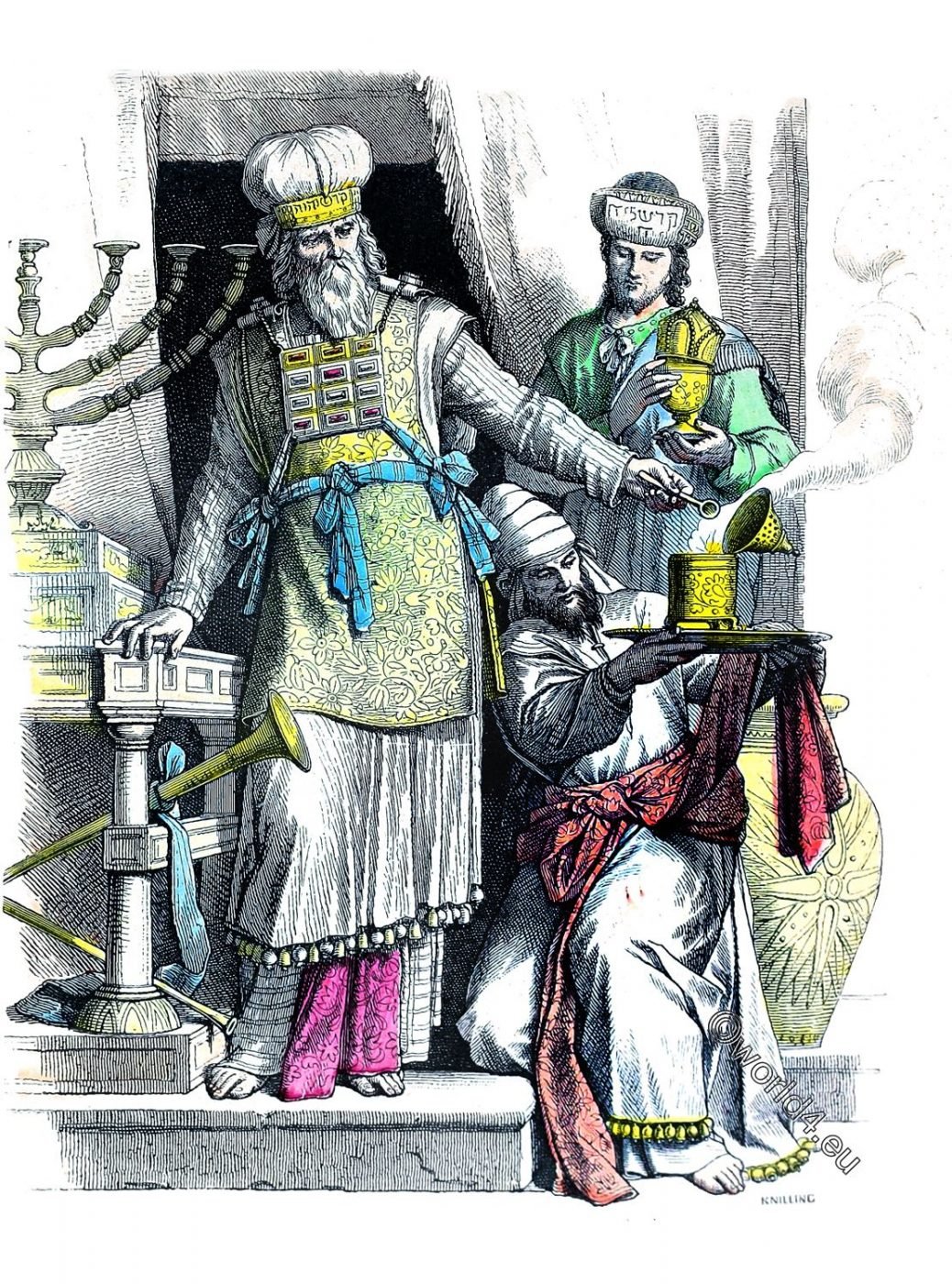
EGYPTIAN TYPES.
The Ephod of the high priest – No. 13 and 14.
The ephod finds its model in a kind of linen bodice with patterns in gold fabric, such as the one that King Amasis, after Herodotus, donated to the sanctuary of Athena Lindia on the island of Rhodes.
The Hoschen, Number 14.
The highest judge of the Egyptians wore around his neck on a golden chain a symbol of precious stones called “the truth”. Such jewels are in the museums of the Louvre and in the first Egyptian Museum of Bulaq, a district of the Egyptian capital Cairo, and are quite similar to the description of the Hoschen.
The headgear of the ancient Egyptian high priest, nos. 1, 2, 11 and 12.
The shape of the minezophet cannot be determined exactly. In any case, the metal plate on the front part of the cap, which is usually turban-like, seems to be related to the original type of the Uraeus serpent, which, as shown in nos. 1 and 2, weakened into a ribbon-like tiara. Nos. 11 and 12 show that this headband only extended from one ear to the other at the front.
The Mehil of the high priest, No. 19; the grenades and bells, Nos. 3, 4, 5, 6 and 7.
The trimming of the Mehil, a long tunic, consisted of bells and coloured pomegranates. The shape of this tunic probably corresponds to the Egyptian garment shown under No. 19. Blue, yellow, red and white pomegranates of enamelled clay and gold bells, Egyptian in origin, as they may have served as trimming for the tunic, are found in large numbers in the Louvre.
COSTUME OF THE LEVITES.
The linen trousers, nos. 13, 14, 16 and 17.
In the bas-reliefs and paintings of the Egyptians, the linen trousers are often the only item of clothing, or they are visible under the long tunic. It reaches from the belt to the knees. The Semites on the monuments of Nineveh and Babylon also wear them.
The priestly tunic, kutonet, no. 19.
It is an undergarment or shirt, wrinkle-free, tight-fitting, reaches down to the feet and is provided with attached sleeves. Worn when they served in the Tabernacle and the Temple in Jerusalem.
The belt, Abnet, number 15, 16 and 17.
Whether this belt was white or coloured is hard to decide. Jerome, Josephus and the rabbis choose the latter and say that it was woven in the four symbolic colours of the ephod. It would then correspond in form to the Egyptian belt no. 17 with its numerous bands, and in colour and pattern to the belts illustrated under nos. 15 and 16.
Almost on every page of Leviticus *), Moses mentions that the clothing of the priests must be made of linen. The priests of Ammon and Isis are also called linigeri, linen bearers, in ancient times.
*) Third book of the Torah. It is called Πεντάτευχος (Pentáteuchos) in Greek. The book contains the teaching of the Kohanim (priests) and their tasks.
Nos. 1, 2, 4, 5, 6 and 12 at the Louvre Museum.
Nos. 3, 7 and 14 from Prisse d’Avegnes, l’Art égyptien
Nos. 13, 17 and 19 from Lepsius, Monuments.
No. 8 from a Biblia sacra, Antwerp, 1583; nos. 9 and 10 from a Bible by Royaumont, 1694; nos. 18, 20 and 21 from the Univers pittoresque, (Palestine of S. Munk).
See the brochure of Abbé Ancessi, l’Egypte et Moïse, 1875.
The Hebrews (Hebrew עִבְרִי ʿivri or Iwri) are early members of the Israelites in the Hebrew Bible, and later also their descendants, the Jews. The Aramaic word ʿebrāyā means something like “the arrived”. Perhaps this is what the Hebrews were called, because according to the Old Testament they were chosen by God to enter the promised land (Israel today).
The origin of the name comes from the Torah (Genesis 14:13). Arch-father Abraham was the first to be called Iwri, because he immigrated to Canaan from across the Jordan at God’s command. Later in Egypt, Joseph was called Iwri, ‘Hebrew Boy’. As a group in the Tanach, the Israelites are also called Iwrim in other contexts. The expression occurs 33 times in the Tanach / Old Testament. Almost always strangers use the word towards Israelites or these towards strangers. With the foreign word always a disdain or contempt is expressed, with the proper term humility. Roland de Vaux interpreted the term “Hebrews” as an ethnic term for groups that had advanced from the desert into cultivated land.
Source: History of the costume in chronological development by Albert Charles Auguste Racinet. Edited by Adolf Rosenberg. Berlin 1888.
Related
Discover more from World4 Costume Culture History
Subscribe to get the latest posts sent to your email.




